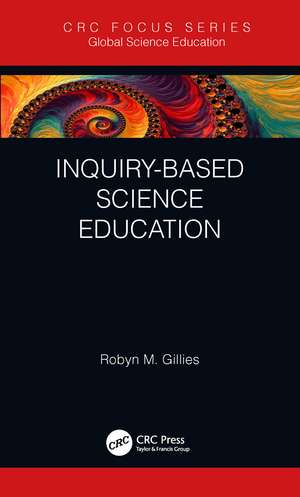Inquiry-based Science Education: Global Science Education
Autor Robyn M. Gilliesen Limba Engleză Hardback – 11 feb 2020
Key Features:
- Presents processes involved in teaching inquiry-based science
- Discusses importance of multi-modal representations in teaching inquiry based-science
- Covers ways to develop scientifically literacy
- Uses the Structure of Observed learning Outcomes (SOLO) Taxonomy to assess student reasoning, problem-solving and learning
- Presents ways to promote scientific discourse, including teacher-student interactions, student-student interactions, and meta-cognitive thinking
| Toate formatele și edițiile | Preț | Express |
|---|---|---|
| Paperback (1) | 125.83 lei 6-8 săpt. | |
| CRC Press – 14 oct 2024 | 125.83 lei 6-8 săpt. | |
| Hardback (1) | 420.32 lei 6-8 săpt. | |
| CRC Press – 11 feb 2020 | 420.32 lei 6-8 săpt. |
Preț: 420.32 lei
Preț vechi: 494.49 lei
-15% Nou
Puncte Express: 630
Preț estimativ în valută:
80.43€ • 84.15$ • 66.81£
80.43€ • 84.15$ • 66.81£
Carte tipărită la comandă
Livrare economică 02-16 aprilie
Preluare comenzi: 021 569.72.76
Specificații
ISBN-13: 9780367279233
ISBN-10: 0367279231
Pagini: 122
Ilustrații: 10
Dimensiuni: 138 x 216 x 13 mm
Greutate: 0.26 kg
Ediția:1
Editura: CRC Press
Colecția CRC Press
Seria Global Science Education
Locul publicării:Boca Raton, United States
ISBN-10: 0367279231
Pagini: 122
Ilustrații: 10
Dimensiuni: 138 x 216 x 13 mm
Greutate: 0.26 kg
Ediția:1
Editura: CRC Press
Colecția CRC Press
Seria Global Science Education
Locul publicării:Boca Raton, United States
Public țintă
AcademicCuprins
Chapter 1: Inquiry-based science
BACKGROUND
INQUIRY-BASED SCIENCE
USING INQUIRY-BASED SCIENCE TO CHALLENGE THINKING
Cooperative Learning Activities
Strategies to help students learn to work cooperatively together
Group size
Group composition.
Type of task
Individual reflection activity
Group’s Action Plan
Characteristics of Complex Tasks
CHALLENGES IMPLEMENTING INQUIRY-BASED SCIENCE
CHAPTER SUMMARY
ADDITIONAL READINGS
Chapter 2: Visual, embodied and language representations in teaching inquiry based-science: A case study
INTRODUCTION
TYPES OF REPRESENTATIONS
Purpose of the case study
METHOD
Context for the study
Inquiry-based science unit
Data collection
Teacher measures
RESULTS AND DISCUSSION
The inquiry-based science lessons
Lesson 1: Engage
Lesson 2: Explore
Lesson 3: Explain
Lesson 4: Elaborate
Lesson 5: Evaluate
CHAPTER SUMMARY
ADDITIONAL READINGS
Chapter 3: Developing scientific literacy
INTRODUCTION
BACKGROUND
SCIENTIFIC LITERACY
Questions that challenge children’s understandings
Question Stems and Cognitive Processes
The discourse of science
Encouraging audience participation
Linguistic Tools that promote student discussion
Accountable Talk
Exploratory Talk
Philosophy for Children (P4C)
CHAPTER SUMMARY
ADDITIONAL READINGS
Chapter 4: Promoting scientific discourse
INTRODUCTION
DIALOGIC TEACHING
Example of Dialogic Teaching
Dialogic interactions in a cooperative group setting
STRATEGIES TO PROMOTE DIALOGIC INTERACTIONS
DIALOGIC STRATEGIES FOR STUDENTS
Critical Thinking Skills
CHAPTER SUMMARY
ADDITIONAL READINGS
Chapter 5: Structuring cooperative learning to promote social and academic learning
INTRODUCTION
COOPERATIVE LEARNING
BENEFITS OF COOPERATIVE LEARNING
Advantages of small, cooperative group instruction
Types of cooperative learning groups
KEY ELEMENTS IN COOPERATIVE LEARNING
Skills that Facilitate Interpersonal Communication
STRATEGIES FOR CONSTRUCTING COOPERATION IN GROUPS
STRATEGIES FOR ASSESSING COOPERATIVE LEARNING
CHAPTER SUMMARY
ADDITIONAL READINGS
Chapter 6: The Structure of Observed Learning Outcomes (SOLO) Taxonomy: Assessing students’ reasoning, problem-solving and learning
INTRODUCTION
THE SOLO TAXONOMY
FIVE LEVELS OF THE SOLO TAXONOMY
INTENDED LEARNING OUTCOMES
Examples of the increasing complexity in students’ language: Using the SOLO Taxonomy
CHAPTER SUMMARY
ADDITIONAL READINGS
BACKGROUND
INQUIRY-BASED SCIENCE
USING INQUIRY-BASED SCIENCE TO CHALLENGE THINKING
Cooperative Learning Activities
Strategies to help students learn to work cooperatively together
Group size
Group composition.
Type of task
Individual reflection activity
Group’s Action Plan
Characteristics of Complex Tasks
CHALLENGES IMPLEMENTING INQUIRY-BASED SCIENCE
CHAPTER SUMMARY
ADDITIONAL READINGS
Chapter 2: Visual, embodied and language representations in teaching inquiry based-science: A case study
INTRODUCTION
TYPES OF REPRESENTATIONS
Purpose of the case study
METHOD
Context for the study
Inquiry-based science unit
Data collection
Teacher measures
RESULTS AND DISCUSSION
The inquiry-based science lessons
Lesson 1: Engage
Lesson 2: Explore
Lesson 3: Explain
Lesson 4: Elaborate
Lesson 5: Evaluate
CHAPTER SUMMARY
ADDITIONAL READINGS
Chapter 3: Developing scientific literacy
INTRODUCTION
BACKGROUND
SCIENTIFIC LITERACY
Questions that challenge children’s understandings
Question Stems and Cognitive Processes
The discourse of science
Encouraging audience participation
Linguistic Tools that promote student discussion
Accountable Talk
Exploratory Talk
Philosophy for Children (P4C)
CHAPTER SUMMARY
ADDITIONAL READINGS
Chapter 4: Promoting scientific discourse
INTRODUCTION
DIALOGIC TEACHING
Example of Dialogic Teaching
Dialogic interactions in a cooperative group setting
STRATEGIES TO PROMOTE DIALOGIC INTERACTIONS
DIALOGIC STRATEGIES FOR STUDENTS
Critical Thinking Skills
CHAPTER SUMMARY
ADDITIONAL READINGS
Chapter 5: Structuring cooperative learning to promote social and academic learning
INTRODUCTION
COOPERATIVE LEARNING
BENEFITS OF COOPERATIVE LEARNING
Advantages of small, cooperative group instruction
Types of cooperative learning groups
KEY ELEMENTS IN COOPERATIVE LEARNING
Skills that Facilitate Interpersonal Communication
STRATEGIES FOR CONSTRUCTING COOPERATION IN GROUPS
STRATEGIES FOR ASSESSING COOPERATIVE LEARNING
CHAPTER SUMMARY
ADDITIONAL READINGS
Chapter 6: The Structure of Observed Learning Outcomes (SOLO) Taxonomy: Assessing students’ reasoning, problem-solving and learning
INTRODUCTION
THE SOLO TAXONOMY
FIVE LEVELS OF THE SOLO TAXONOMY
INTENDED LEARNING OUTCOMES
Examples of the increasing complexity in students’ language: Using the SOLO Taxonomy
CHAPTER SUMMARY
ADDITIONAL READINGS
Notă biografică
Professor Robyn Gillies has worked extensively in both primary and secondary schools to embed STEM education initiatives into the science curriculum. This includes helping teachers to embed inquiry skills into the science curricula so they capture students’ interests, provide opportunities for them to explore possible solutions to problems, explain phenomena, elaborate on potential outcomes, and evaluate findings. Professor Gillies is a Chief Investigator on the Science of Learning Research Centre (SLRC), her recommendations on how teachers can translate research into practice have been widely profiled in the international literature and on the website of the Smithsonian Science Education Center in Washington, DC.
Descriere
Challenges educators to reconsider the approaches used to support student learning in the classroom. This thought-provoking volume presents research evidence to support arguments and provides teachers with frameworks within which they can embed new approaches in ways that support student development in academic and transferable contexts.









